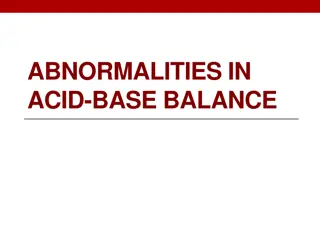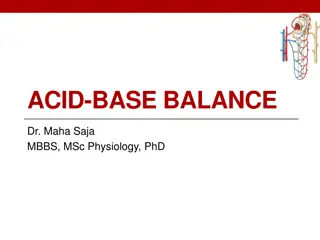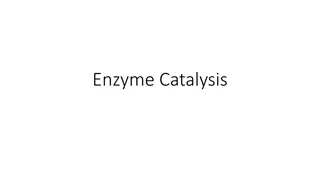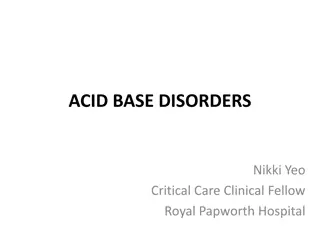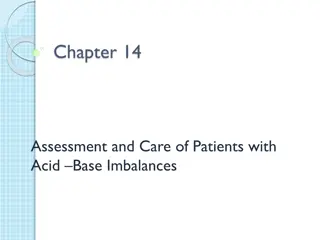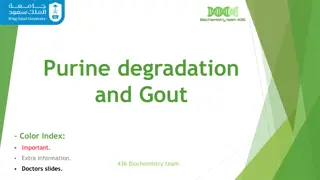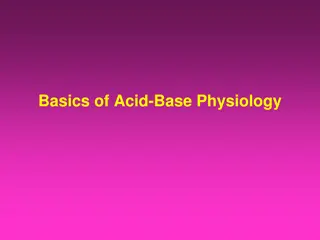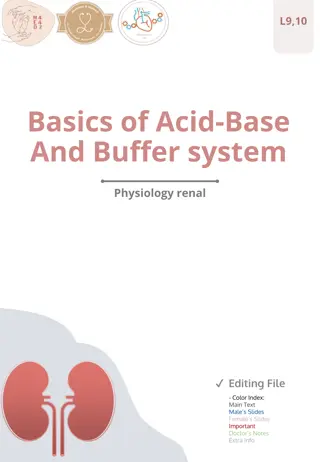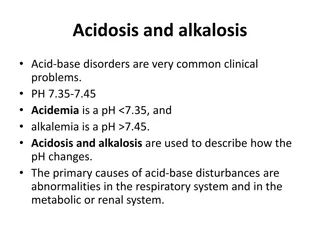Comprehensive Guide to Acid-Base Disorders Interpretation
This comprehensive guide provides a systematic approach to interpreting arterial blood gas (ABG) samples, including multiple formulas and rules to navigate complex diagnoses. It outlines five essential steps in acid-base analysis and emphasizes the importance of routine application for improving patient care in Riyadh, Saudi Arabia.
Download Presentation

Please find below an Image/Link to download the presentation.
The content on the website is provided AS IS for your information and personal use only. It may not be sold, licensed, or shared on other websites without obtaining consent from the author.If you encounter any issues during the download, it is possible that the publisher has removed the file from their server.
You are allowed to download the files provided on this website for personal or commercial use, subject to the condition that they are used lawfully. All files are the property of their respective owners.
The content on the website is provided AS IS for your information and personal use only. It may not be sold, licensed, or shared on other websites without obtaining consent from the author.
E N D
Presentation Transcript
http://www.esemconference.ae/images/logo.png . Acid Base Disorders Abdullah Alsakka MD SBEM ABEM JBEM Clinical Assistant Professor Medical Director King Khalid University Hospital Head of Saudi Counsil for Emergency Medicine Head of Arab Board for Emergency Medicicne Riyadh, Saudi Arabia
Objectives To provide a simple, systematic approach to interpreting arterial blood gas (ABG) samples.
Multiple formulas and rules exist to help guide us through the forest of diagnoses and complex problems All that is needed is a little clinical information obtained from a history and physical examination, a few readily available laboratory tests, and the knowledge of five simple steps.
Getting in the routine of performing these steps on each patient in which an ABG and electrolytes are performed will help decrease the rate of missed complex acid-base disturbances and hopefully improve patient care
Five Steps of Acid-Base Analysis1-5 Step 1: Acidemia (pH <7.38) or alkalemia (pH >7.42)? Step 2: Primary respiratory or metabolic disturbance? (Look at PCO2 and pH) Step 3: Is there appropriate compensation for the primary disorder? Metabolic acidosis: PCO2 = [1.5 x (serum HCO3)] + 8 ( 2) Metabolic alkalosis: PCO2 = 0.6 x HCO3 ( 2) Respiratory acidosis: PCO2 10, HCO3 by 1 (acute) or 4 (chronic) Respiratory alkalosis: PCO2 10, HCO3 by 2 (acute) or 5 (chronic) Step 4: Is there an anion gap metabolic acidosis (AGMA)? AG = Na - (HCO3 + Cl). If > 12, an AGMA is present. Step 5: If metabolic acidosis, is there another concomitant metabolic disturbance? If AGMA, then calculate Gap = AG HCO3 = (AG -12) (24 HCO3) If the Gap is > 6, there is a combined AGMA and metabolic alkalosis. If the Gap is < -6, there is a combined AGMA and NAGMA. If NAGMA, for every 1 mEq/L Cl, there should be a 1 mEq/L HCO3 ( 5). If HCO3 decrease is less than predicted, then NAGMA and metabolic alkalosis.
Five Steps of Acid-Base Analysis1-5 Step 1: Acidemia (pH <7.38) or alkalemia (pH >7.42)?
Five Steps of Acid-Base Analysis1-5 Step 2: Primary respiratory or metabolic disturbance? (Look at PCO2 and pH.) If pH and PCO2 going in same direction Metabolic If pH and PCO2 going in same direction Respiratory
Five Steps of Acid-Base Analysis1-5 Step 3: Is there appropriate compensation for the primary disorder? Metabolic acidosis: PCO2 = [1.5 x (serum HCO3)] + 8 ( 2) Metabolic alkalosis: PCO2 = 0.6 x HCO3 ( 2) Respiratory acidosis: PCO2 10, HCO3 by 1 (acute) or 4 (chronic) Respiratory alkalosis: PCO2 10, HCO3 by 2 (acute) or 5 (chronic)
Five Steps of Acid-Base Analysis1-5 Step 4: Is there an anion gap metabolic acidosis (AGMA)? AG = Na - (HCO3 + Cl). If > 12, an AGMA is present
Five Steps of Acid-Base Analysis1-5 Step 5: If metabolic acidosis, is there another concomitant metabolic disturbance? If AGMA, then calculate Gap = AG HCO3 = (AG - 12) (24 HCO3) If the Gap is > 6, there is a combined AGMA and metabolic alkalosis If the Gap is < -6, there is a combined AGMA and NAGMA.
Five Steps of Acid-Base Analysis1-5 If NAGMA, for every 1 mEq/L Cl, there should be a 1 mEq/L HCO3 ( 5). If HCO3 decrease is less than predicted, then NAGMA and metabolic alkalosis
Metabolic Acidosis In the presence of a pH < 7.38, metabolic acidosis is diagnosed as a primary condition when the pCO2 is < 40 mmHg or the bicarbonate is < 24 mEq/L. Metabolic acidosis can be further classified based on the presence of an anion gap. The anion gap reflects the balance between positively and negatively charged particles in the blood.
Sodium is the only significant positively charge particle that is measured, while the measured anions are chloride and bicarbonate. Therefore, the anion gap is calculated by the formula: Na (Cl + HCO3).
One potential pitfall in the measurement of the anion gap is patients with low albumin. Albumin has several negative charges on it and therefore, in a patient with a low albumin level, their normal anion gap might be much lower than 12. For every 1 gram drop in serum albumin level, the anion gap decreases by 2.5. A patient with a calculated anion gap of 10 and a 2 gram drop in their albumin may actually have an anion gap metabolic acidosis (recalculated AG 15).
Anion Gap Metabolic Acidosis (AGMA) Detection of an AGMA is important because only a few conditions commonly cause it. In addition, in mixed acid-base disorders, an elevation in the anion gap may be the only signal that a metabolic acidosis is present. The causes of an AGMA are divided into four main categories: renal failure, ketoacidosis, toxins, and lactic acidosis
Metabolicacidosis A CAT MUDPILES: Analgesics (massive NSAID, acetaminophen) o Cyanide, Carbon monoxide Arsenic, Alcoholic ketoacidosis Toluene o Methanol, Metformin o Uremia o Diabetic ketoacidosis Paraldehyde, Phenformin Iron, Isoniazid Lactic acidosis Ethylene glycol Salicylates
In any patient with an AGMA, calculate an osmol gap. Osmol gaps are a clue to a potentially life-threatening toxic alcohol ingestion (ie. ethylene glycol and methanol). The osmol gap is determined by subtracting the calculated osmolality from the measured osmolality. Calculated osmolality = 2(Na) + Glc/18 + BUN/2.4 + ETOH/4.6
32 year old man with depression and alcohol abuse presents with altered mental status. ABG: pH 6.9, pCO2 29, pO2 100 Metabolic panel: Na 140, Cl 101, HCO3 5
Step 1: Acidosis Step 2: Metabolic Step 3: pCO2 = 1.5(HCO3) + 8 = 15, but the patient s pCO2 is higher than 15. Therefore, a respiratory acidosis is also present, possibly secondary to CNS depression. Step 4: AG = 140 (101 + 5) = 34 Step 5: Delta gap = (34-12) (24-5) = 3. No additional metabolic disorders other than AGMA. Answer: Anion gap metabolic acidosis and respiratory acidosis. The patient had an osmol gap of 174 and a methanol level of 510 mg/dL.
Non-Anion Gap Metabolic Acidosis (NAGMA) A NAGMA is due to either GI or renal losses of bicarbonate. If desired, GI mediated and renally mediated losses can be distinguished by obtaining urine electrolytes (ie. Na, K, and Cl) and calculating the urine anion gap. The urine anion gap : Na + K - Cl The urine anion gap is the difference between the spot urine positive ions and spot urine negative ions. If an excess of negatively charged ions is present, the acidemia is due to the kidney
A 68 year old man who recently took antibiotics for a skin infection presents with 10 episodes of watery diarrhea per day for the last 5 days. ABG: pH 7.34, pCO2 34, pO2 80 Metabolic panel: Na 135, Cl 108, HCO3 18
Step 1: Acidosis Step 2: Metabolic Step 3: pCO2 = 1.5(HCO3) + 8 = 35 Step 4: AG = 135 (108 + 18) = 9 Step 5: Cl by 8 and HCO3 by 6; therefore there is no metabolic alkalosis. Answer: NAGMA due to diarrhea
Respiratory acidosis Respiratory acidosis is characterized by an elevation in the pCO2 and a decrease in blood pH due most commonly to hypoventilation. It results from conditions that decrease the ability of the lungs to excrete carbon dioxide at a rate to keep up with the body s production.
A differential diagnosis includes: Central nervous system depression (sedatives, CNS disease, sleep apnea) Pleural disease (large pneumothorax or pleural effusion) Lung disease (ARDS, COPD, pulmonary edema, severe pneumonia) Acute airway obstruction (laryngospasm, sleep apnea) Neuromuscular disorders (GBS, myasthenia gravis, botulism) Thoracic cage injury (flail chest) Ventilator dysfunction
The kidney compensates for primary respiratory acidosis by retaining bicarbonate. This compensation occurs over hours to days and is generally at a maximum within four days. The rate of onset of respiratory acidosis can be determined by the degree of renal compensation (increase in HCO3) as listed above in step 3.
Alternatively, the chronicity of the respiratory acidosis can be predicted by the change in the pH. In acute respiratory acidosis, the pH decreases by 0.08 units for each increase of 10 mmHg in the pCO2 from its baseline of 40 mmHg. Chronic respiratory acidosis is marked by a decrease in the pH of 0.03 units for every increase of 10 mmHg in the pCO2.
Differentiating acute from chronic respiratory conditions can have important clinical implications that may alert the clinician to a patient that is rapidly spiraling downward and might require emergent intubation, from a patient who has chronic disease, but is in less danger of imminent decompensation
A 70 year-old smoker presents with an acute onset of shortness of breath. ABG: pH 7.30, pCO2 = 60 mmHg, pO2 60 mmHg Metabolic panel: Na 135, Cl 100, HCO3 30
Step 1: Acidosis Step 2: Respiratory Step 3: Acute on chronic. pCO2 increased by 20, therefore the HCO3 should increase by 2 if acute and 8 if chronic. Because the HCO3 increased from 24 to 30 (6), an acute on chronic respiratory acidosis is present. Step 4: AG = 135-(100+26) = 9. No anion gap metabolic acidosis Step 5: XX Answer: Acute on chronic respiratory acidosis due to COPD exacerbation
Metabolic alkalosis Metabolic alkalosis is characterized by an increase in the serum bicarbonate concentration. The causes of metabolic alkalosis are : Volume contraction (vomiting, NG suction, loop or thiazide diuretics). Excess glucocorticoids or mineralocorticoids (eg, Cushing s syndrome). Hypokalemia Bartter s syndrome. Alkali ingestion/infusion. Post-hypercapnic alkalosis
To differentiate the most common cause of metabolic alkalosis which is volume depletion from other causes you need to measure urine chloride If urine chloride lees than 10 this due to volume depletion(saline respnce) If urine chloride more than 10 this due to other causes (saline resistance)
Example 4: A 20 year old student presents with excessive vomiting after binge drinking. ABG: pH 7.50, pCO2 44, pO2 100 Metabolic panel: Na 138, Cl 100, HCO3 30
Step 1: Alkalosis Step 2: Metabolic Step 3: Increase in pCO2 should equal 0.6 multiplied by the elevation of the HCO3 2. The increase of the pCO2 of 4 is within two of 6(0.6) or 3.6; therefore there is appropriate compensation. Step 4: AG = 138 (100 + 30) = 8 Step 5: XX Answer: Metabolic alkalosis secondary to vomiting
Respiratory alkalosis Respiratory alkalosis is characterized by a decrease in the pCO2 and an elevation in the blood pH. The pO2 can be used to distinguish between disease of the lungs and other causes of hyperpnea (eg, fever)
The causes of a primary respiratory alkalosis include: CNS disease (CVA) o Toxins (Salicylates) High altitude Severe anemia Pregnancy Lung disease/hypoxia (asthma, pneumonia, PE, pulmonary edema, pulmonary fibrosis) Anxiety o Cirrhosis of the liver Fever (Sepsis) Ventilator dysfunction
A 22 year-old woman presents with 4 hours of numbness in both hands typical of previous episodes of anxiety. ABG: pH 7.48, pCO2 30 mmHg, pO2 86 mmHg Metabolic panel: Na 140, Cl 110, HCO3 22
Step 1: Alkalosis Step 2: Respiratory Step 3: Acute. Drop in the pCO2 by 10 corresponds to a drop in the HCO3 by 2 if acute and 5 if chronic. 24-22 = 2 and therefore, as would be expected by the clinical history, an acute disorder is diagnosed. Step 4: AG 140-(110+22) = 8 Step 5: XX Answer: Acute respiratory alkalosis secondary to a panic attack
Practice Cases CASE 1 A diabetic presents with diarrhea and cough. CXR reveals an infiltrate. pH 7.31; pCO2 10 Na 123; Cl 99; HCO3 5
Primary AGMA (DKA), respiratory alkalosis (pneumonia), NAGMA (diarrhea)
CASE 2 An alcoholic presents with vomiting. pH 7.20; pCO2 25 Na 130; Cl 80; HCO3 10
Primary AGMA (alcoholic ketoacidosis), metabolic alkalosis (vomiting)
CASE 3 A man with arthritis presents with confusion, shortness of breath, and diaphoresis. pH 7.30; pCO2 18 Na 147; Cl 108; HCO3 16
Primary AGMA and respiratory alkalosis (Salicylate toxicity 107 mg/dl)
CASE 4 A patient with COPD presents with shortness of breath. pH 7.18; pCO2 80 Na 135; Cl 93; HCO3 30
Primary respiratory acidosisacute-on-chronic (COPD exacerbation)
CASE 5 A woman with Crohn s disease presents with fever, vomiting, and diarrhea. pH 7.36; pCO2 22 Na 147; Cl 121; HCO3 14
Primary NAGMA (diarrhea), respiratory alkalosis (fever), metabolic alkalosis (vomiting)
CASE 6 A noncompliant patient with diabetes and cirrhosis presents with vomiting. pH 7.46; pCO2 17 Na 133; Cl 84; HCO3 15
Primary chronic respiratory alkalosis (cirrhosis), AGMA (DKA), metabolic alkalosis



